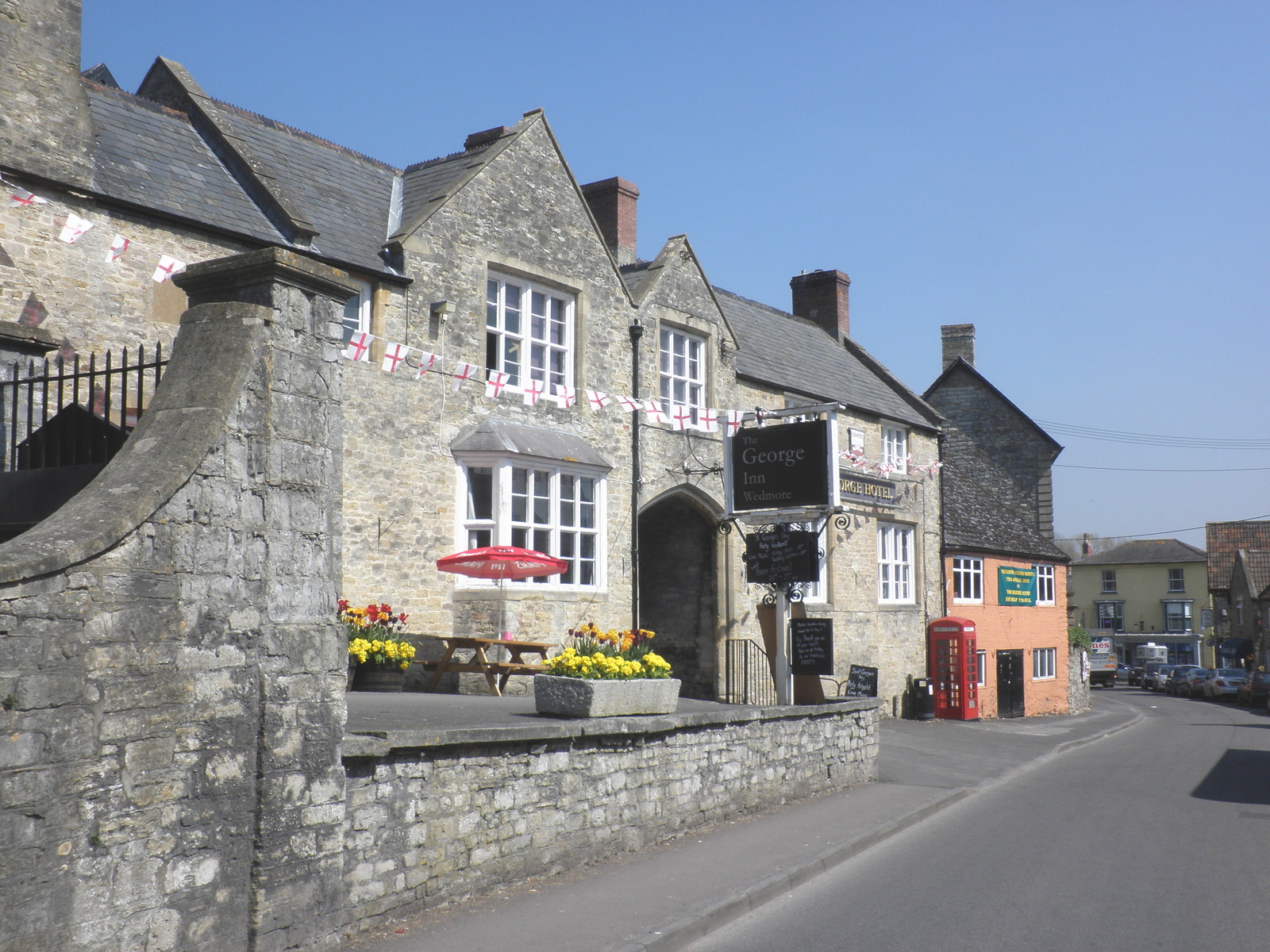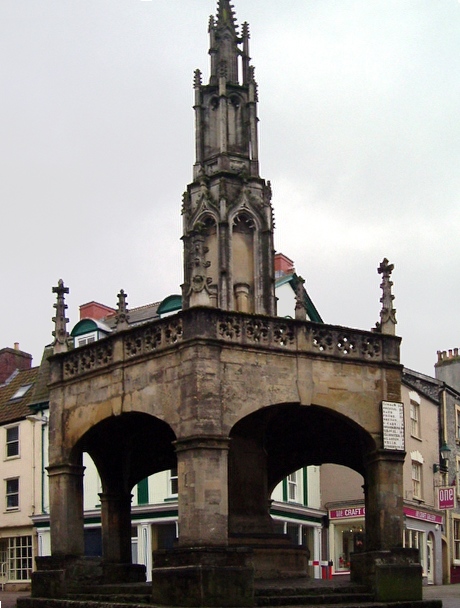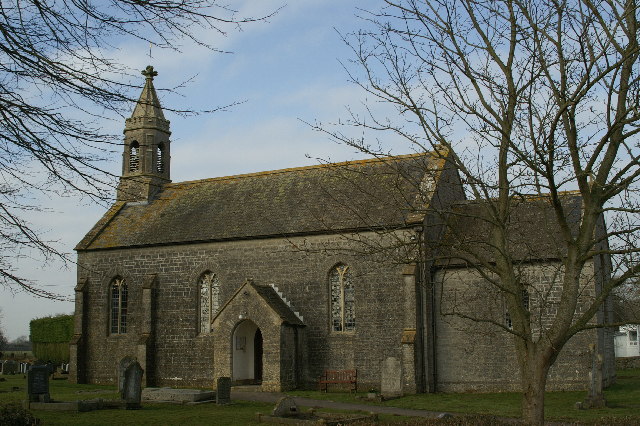|
Holy Trinity Church, Blackford
Holy Trinity Church is a Church of England church in Blackford, Somerset, England. It was built in 1821–23 to the designs of Richard Carver and has been a Grade II listed building since 1961. History Holy Trinity Church was built as a chapel of ease to the parish church of St Mary in Wedmore. As a result of the growing population of the parish during the early 19th century, the vicar of Wedmore, the Rev. John Richards, sought to provide additional church accommodation for the outlying parts of the parish. The population of Wedmore had reached over 3,000 and the parish church was only capable of accommodating 700 people. The hamlet of Blackford was selected as the location for the first chapel of ease, which would also serve the inhabitants of Westham and West Stoughton, all of whom were approximately two miles from the parish church. Plans for the church were drawn up by Richard Carver of Taunton, with seating for 300 people, 200 of which would be free and unappropriated for ... [...More Info...] [...Related Items...] OR: [Wikipedia] [Google] [Baidu] |
Wedmore
Wedmore is a large village and civil parish in the county of Somerset, England. It is situated on raised ground, in the Somerset Levels between the River Axe and River Brue, often called the Isle of Wedmore. It forms part of Sedgemoor district. The parish consists of three main villages: Wedmore, Blackford and Theale, with the 17 hamlets of Bagley, Blakeway, Clewer, Crickham, Cocklake, Heath House, Latcham, Little Ireland, Middle Stoughton, Mudgley, Panborough, Sand, Stoughton Cross, Washbrook, West End, West Ham and West Stoughton. The parish of Wedmore has a population of 3,318 according to the 2011 census. Its facilities include a medical and dental practice, pharmacy, butcher's, a village store with off licence, three pubs, restaurant, café and several other local shops. It is south of Cheddar, west of the city of Wells and north west of Glastonbury. Etymology The name ''Wedmore'' in Old English is thought to mean "hunting lodge" or "hunting moor"; there was a Saxon ro ... [...More Info...] [...Related Items...] OR: [Wikipedia] [Google] [Baidu] |
Lord Arthur Hervey
Lord Arthur Charles Hervey (20 August 1808 – 9 June 1894) was an English bishop who served as Bishop of Bath and Wells from 1869 to 1894. He was usually known by his aristocratic courtesy title, "Lord", rather than the style appropriate to a bishop, the Right Reverend. Background and education Hervey was the fourth son of Frederick Hervey, 1st Marquess of Bristol, by Elizabeth Albana Upton, daughter of Clotworthy Upton, 1st Baron Templetown. His paternal grandfather was Frederick Hervey, 4th Earl of Bristol, the Bishop of Derry. He was born at his father's London house, 6 St James's Square, on 20 August 1808. From 1817 to 1822, he lived abroad with his parents, chiefly in Paris, and was taught by a private tutor. He entered Eton College in 1822 and remained there until 1826. He entered Trinity College, Cambridge, in 1827, and after a residence of two years and a half, obtained a first class in the classical tripos and graduated B.A. in 1830. Career Having been ordained ... [...More Info...] [...Related Items...] OR: [Wikipedia] [Google] [Baidu] |
Church Of England Church Buildings In Sedgemoor
Church may refer to: Religion * Church (building), a building for Christian religious activities * Church (congregation), a local congregation of a Christian denomination * Church service, a formalized period of Christian communal worship * Christian denomination, a Christian organization with distinct doctrine and practice * Christian Church, either the collective body of all Christian believers, or early Christianity Places United Kingdom * Church (Liverpool ward), a Liverpool City Council ward * Church (Reading ward), a Reading Borough Council ward * Church (Sefton ward), a Metropolitan Borough of Sefton ward * Church, Lancashire, England United States * Church, Iowa, an unincorporated community * Church Lake, a lake in Minnesota Arts, entertainment, and media * '' Church magazine'', a pastoral theology magazine published by the National Pastoral Life Center Fictional entities * Church (''Red vs. Blue''), a fictional character in the video web series ''Red vs. Blue'' ... [...More Info...] [...Related Items...] OR: [Wikipedia] [Google] [Baidu] |
Churches In Somerset
Church may refer to: Religion * Church (building), a building for Christian religious activities * Church (congregation), a local congregation of a Christian denomination * Church service, a formalized period of Christian communal worship * Christian denomination, a Christian organization with distinct doctrine and practice * Christian Church, either the collective body of all Christian believers, or early Christianity Places United Kingdom * Church (Liverpool ward), a Liverpool City Council ward * Church (Reading ward), a Reading Borough Council ward * Church (Sefton ward), a Metropolitan Borough of Sefton ward * Church, Lancashire, England United States * Church, Iowa, an unincorporated community * Church Lake, a lake in Minnesota Arts, entertainment, and media * '' Church magazine'', a pastoral theology magazine published by the National Pastoral Life Center Fictional entities * Church (''Red vs. Blue''), a fictional character in the video web series ''Red vs. Blue'' * Chur ... [...More Info...] [...Related Items...] OR: [Wikipedia] [Google] [Baidu] |
Vestry
A vestry was a committee for the local secular and ecclesiastical government for a parish in England, Wales and some English colonies which originally met in the vestry or sacristy of the parish church, and consequently became known colloquially as the "vestry". Overview For many centuries, in the absence of any other authority (which there would be in an incorporated city or town), the vestries were the sole ''de facto'' local government in most of the country, and presided over local, communal fundraising and expenditure until the mid or late 19th century using local established Church chairmanship. They were concerned for the spiritual but also the temporal as well as physical welfare of parishioners and its parish amenities, collecting local rates or taxes and taking responsibility for numerous functions such as the care of the poor, the maintaining of roads, and law enforcement, etc. More punitive matters were dealt with by the manorial court and hundred court, and latter ... [...More Info...] [...Related Items...] OR: [Wikipedia] [Google] [Baidu] |
Chancel
In church architecture, the chancel is the space around the altar, including the choir and the sanctuary (sometimes called the presbytery), at the liturgical east end of a traditional Christian church building. It may terminate in an apse. Overview The chancel is generally the area used by the clergy and choir during worship, while the congregation is in the nave. Direct access may be provided by a priest's door, usually on the south side of the church. This is one definition, sometimes called the "strict" one; in practice in churches where the eastern end contains other elements such as an ambulatory and side chapels, these are also often counted as part of the chancel, especially when discussing architecture. In smaller churches, where the altar is backed by the outside east wall and there is no distinct choir, the chancel and sanctuary may be the same area. In churches with a retroquire area behind the altar, this may only be included in the broader definition of chancel. I ... [...More Info...] [...Related Items...] OR: [Wikipedia] [Google] [Baidu] |
Nave
The nave () is the central part of a church, stretching from the (normally western) main entrance or rear wall, to the transepts, or in a church without transepts, to the chancel. When a church contains side aisles, as in a basilica-type building, the strict definition of the term "nave" is restricted to the central aisle. In a broader, more colloquial sense, the nave includes all areas available for the lay worshippers, including the side-aisles and transepts.Cram, Ralph Adams Nave The Catholic Encyclopedia. Vol. 10. New York: Robert Appleton Company, 1911. Accessed 13 July 2018 Either way, the nave is distinct from the area reserved for the choir and clergy. Description The nave extends from the entry—which may have a separate vestibule (the narthex)—to the chancel and may be flanked by lower side-aisles separated from the nave by an arcade. If the aisles are high and of a width comparable to the central nave, the structure is sometimes said to have three naves. ... [...More Info...] [...Related Items...] OR: [Wikipedia] [Google] [Baidu] |
Shepton Mallet
Shepton Mallet is a market town and civil parish in the Mendip District of Somerset, England, some south-west of Bath, south of Bristol and east of Wells. It had an estimated population of 10,810 in 2019. Mendip District Council is based there. The Mendip Hills lie to the north and the River Sheppey runs through the town, as does the route of the Fosse Way, the main Roman road between north-east and south-west England. There is evidence of Roman settlement. Its listed buildings include a medieval parish church. Shepton Mallet Prison was England's oldest, but closed in March 2013. The medieval wool trade gave way to trades such as brewing in the 18th century. It remains noted for cider production. It is the closest town to the Glastonbury Festival and nearby the Royal Bath and West of England Society showground. History Etymology The name Shepton derives from the Old English ''scoep'' and ''tun'', meaning "sheep farm"; the ''Domesday Book'' of 1086 records a settlement kn ... [...More Info...] [...Related Items...] OR: [Wikipedia] [Google] [Baidu] |
English Heritage
English Heritage (officially the English Heritage Trust) is a charity that manages over 400 historic monuments, buildings and places. These include prehistoric sites, medieval castles, Roman forts and country houses. The charity states that it uses these properties to "bring the story of England to life for over 10 million people each year". Within its portfolio are Stonehenge, Dover Castle, Tintagel Castle and the best preserved parts of Hadrian's Wall. English Heritage also manages the London Blue Plaque scheme, which links influential historical figures to particular buildings. When originally formed in 1983, English Heritage was the operating name of an executive non-departmental public body of the British Government, officially titled the Historic Buildings and Monuments Commission for England, that ran the national system of heritage protection and managed a range of historic properties. It was created to combine the roles of existing bodies that had emerged from a long ... [...More Info...] [...Related Items...] OR: [Wikipedia] [Google] [Baidu] |
George Kennion
George Wyndham Kennion, DD (5 September 184519 May 1922), was the Anglican Bishop of Adelaide, and later Bishop of Bath and Wells. Birth and education George Wyndham Kennion, the son of George Kennion and Catherine, daughter of J.F. Fordyce, was born at Harrogate, England, on 5 September 1845. He was educated at Eton College and Oriel College, Oxford, where he graduated B.A. in 1867 and M.A. in 1871. Priesthood He was ordained deacon in 1869 and priest in 1870. He was an inspector of schools 1871–3, vicar of St Paul, Hull, in 1873, and of All Saints, Bradford, in 1876. Bishop of Adelaide In 1882 he was chosen by Archbishop Tait to be the second bishop of Adelaide; and was consecrated a bishop by John Jackson, Bishop of London, at Westminster Abbey on 30 November 1882. On 5 December he married Henrietta, daughter of Sir Charles Dalrymple Fergusson. Kennion arrived in South Australia early in 1883 and soon realised that more churches were needed in the rapidly g ... [...More Info...] [...Related Items...] OR: [Wikipedia] [Google] [Baidu] |
Burtle
Burtle is a village and civil parish on the Somerset Levels in the Sedgemoor district of Somerset, England. History Burtle Priory (also known as Burtle Moor Priory) originated as a hermitage on a site called Sprauellissmede, endowed by William son of Godfrey of Eddington in 1199. It was later known as St Stephens chapel and by 1312 a house of the Augustinian Canons Regular. It is close to the village of Edington and between them was Edington Burtle station on a branch of the Somerset and Dorset Joint Railway, which opened in 1890 and closed on 7 March 1966. Governance The parish council has responsibility for local issues, including setting an annual precept (local rate) to cover the council's operating costs and producing annual accounts for public scrutiny. The parish council evaluates local planning applications and works with the local police, district council officers, and neighbourhood watch groups on matters of crime, security, and traffic. The parish council's role a ... [...More Info...] [...Related Items...] OR: [Wikipedia] [Google] [Baidu] |





.jpg)
